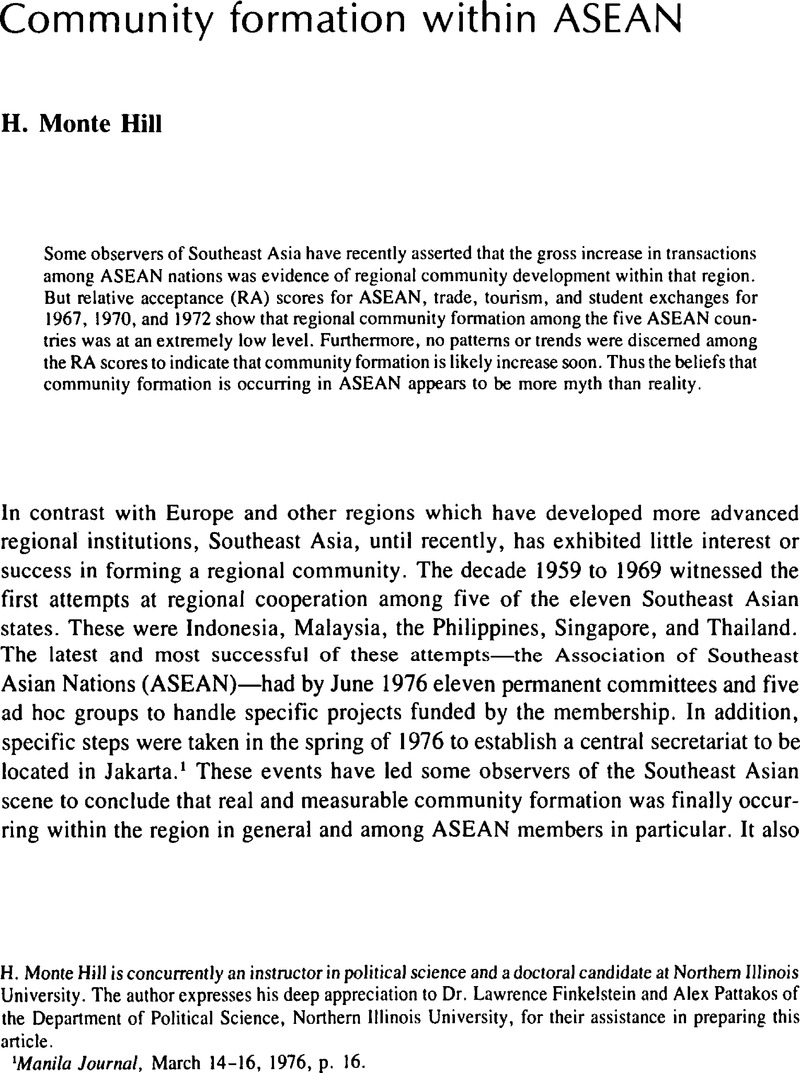Article contents
Community formation within ASEAN
Published online by Cambridge University Press: 22 May 2009
Abstract

- Type
- Research Note
- Information
- Copyright
- Copyright © The IO Foundation 1978
References
1 Manila Journal, March 14–16, 1976, p. 16.
2 For examples of statements regarding regional community development in Southeast Asia, seeSolidum, Estrella D., Towards a Southeast Asian Community (Quezon City: University of Philippines Press, 1976), pp. 210–11;Manila Journal, December 5–11, 1976, p. 5;Google Scholar Asian Review, Vol. l, No. 1 (02 1976): 15Google Scholar.
3 For detailed explanations of Deutsch and Savage's approach see Deutsch, Karl W. and Savage, Richard, “A Statistical Model of the Gross Analysis of Transaction Flows,” Econometrica Vol. 28, No. 3 (07 1960): 551–72Google Scholar. In addition, one should note that there exists substantial controversy about Deutsch and Savage's model. For arguments, pro and con, see Hughes, Barry B., “Transaction Data and Analysis: In Search of Concepts,” International Organization Vol. 26, No. 4 (Autumn 1972): 659–80CrossRefGoogle ScholarChadwick, Richard N., “A Brief Critique of 'Transaction Data and Analysis: 'In Search of Concepts,” by Hughes, Barry B.,” International Organization Vol. 26, No. 4 (Autumn 1972): 681–86;CrossRefGoogle ScholarHughes, Barry B., “A Response to Chadwick, International Organization Vol. 26, No. 4 (Autumn 1976): 687–90;CrossRefGoogle Scholar Alker, Hayward Jr, and Puchala, Donald J., “Trends in Economic Partnership: The North Atlantic Area, 1928–1963,” in Singer, J. David, ed., Quantitative International Politics: Insight and Evidence (New York: Free Press, 1968), pp. 287–316Google Scholar. Brams, Steven J., “Transaction Flows in the International System,” American Political Science Review Vol. 60, No. 4 (12 1966): 880–98CrossRefGoogle Scholar.
4 Myrdal, Gunnar, Asian Drama: An Inquiry into Poverty, Vol. 1 (New York: Pantheon Books, 1972), p.82Google Scholar
5 Efferson, Norman, “Outlook for World Rice Productions and Trade,” in Rice, Science & Man (Los Banos, Phil.: International Rice Research Institute, 1972), p. 132.Google Scholar
6 United Nations, World Energy Supplies (New York: United Nations, ST/STAT/Ser. J./17, 1974), pp. 62–63Google ScholarPubMed.
7 Ad Hoc Committee on Tourism, 1I/ASEAN/JGS/II, Annex B. Opening address of the Minister for Communications of Indonesia at the Second Meeting at Jogjakarta, July 22, 1969, p. 2
8 Obrom, Sifribarn, A Study of the Background and Difficulties of Non-filipino Students Studying the Philippines.: Unpublished M.A. thesis, Southwestern University, 1969), pp. 12–14Google Scholar.
9 Ibid.
10 Ibid.
11 The aggregation of RA scores helps overcome one of the major problems of transactional analysis; that is, the handling of the great number of statistics such a study generates.
- 2
- Cited by




